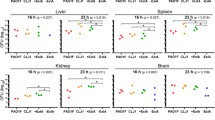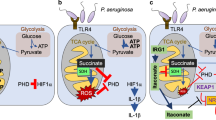Abstract
Pseudomonas aeruginosa, commonly found in environments, can cause chronic lung disease in immunocompromised patients. In previous study, an aerobic desaturase (DesB) in P. aeruginosa exerted considerable effects on virulence factor production. The objective of this study was to analyze the role of DesB on the virulence traits of P. aeruginosa in the host. For the in vitro experiments, cells and supernatants from wild-type (WT) P. aeruginosa and its desB mutant were collected. The diluted cells were added to the A549 cell monolayer in order to determine cell viability, invasion ability, and/or immune response. For the in vivo experiments, 6-week-old ICR mice were infected with 6–7 log CFU bacterial cells using endotracheal intubation. The ratio of lung weight to body weight and survival rate of each bacterial strain in the lung were measured. The histopathology of lung tissue was also studied. desB mutants exhibited lower cytotoxicity in A549 cells. In addition, more pro-inflammatory cytokines and chemokines were present in desB mutant-treated. In the lungs of mouse model, WT survived longer than desB mutant, and the WT migrated from the lung to the liver and spleen. The results suggest that P. aeruginosa DesB affects the pathogenicity of the organism in the host.





Similar content being viewed by others
References
Adamo R, Sokol S, Soong G et al (2000) Pseudomonas aeruginosa flagella activate airway epithelial cells through asialoGM1 and toll-like receptor 2 as well as toll-like receptor 5. Am J Respir Cell Mol Biol 30:627–634
Cowell BA, Evans DJ, Fleiszig SM (2005) Actin cytoskeleton disruption by ExoY and its effects on Pseudomonas aeruginosa invasion. FEMS Microbiol Lett 250:71–76
Garner MR, James KE, Callahan MC, Wiedmann M, Boor KJ (2006) Exposure to salt and organic acids increases the ability of Listeria monocytogenes to invade Caco-2 cells but decreases its ability to survive gastric stress. Appl Environ Microbiol 72:5384–5395
Goldstein I, Bughalo MT, Marquette CH et al (2001) Mechanical ventilation-induced air-space enlargement during experimental pneumonia in piglets. Am J Respir Crit Care Med 163:958–964
Hardalo C, Edberg SC (1997) Pseudomonas aeruginosa: assessment of risk from drinking water. Crit Rev Microbiol 23:47–75
Hauser AR, Fleiszig S, Kang PJ, Mostov K, Engel JN (1998) Defects in type III secretion correlate with internalization of Pseudomonas aeruginosa by epithelial cells. Infect Immun 66:1413–1420
Hoheisel GB, Tabak L, Teschler H, Erkan F, Kroegel C, Costabel U (1994) Bronchoalveolar lavage cytology and immunocytology in pulmonary tuberculosis. Am J Respir Crit Care Med 149:460–463
Holloway BW (1955) Genetic recombination in Pseudomonas aeruginosa. Microbiology 13:572–581
Kasahara K, Tobe T, Tomita M, Mukaida N, Shao-Bo S, Matsushima K, Yoshida T, Sugihara S, Kobayashi K (1994) Selective expression of monocyte chemotactic and activating factor/monocyte chemoattractant protein 1 in human blood monocytes by Mycobacterium tuberculosis. J Infect Dis 170:1238–1247
Kim S, Yoon Y, Choi K-H (2015) Pseudomonas aeruginosa DesB promotes Staphylococcus aureus growth inhibition in coculture by controlling the synthesis of HAQs. PLoS One 10(7):e0134624
Kipnis E, Sawa T, Wiener-Kronish J (2006) Targeting mechanisms of Pseudomonas aeruginosa pathogenesis. Med Mal Infect 36:78–91
Kropinski AM, Lewis V, Berry D (1987) Effect of growth temperature on the lipids, outer membrane proteins, and lipopolysaccharides of Pseudomonas aeruginosa PAO. J Bacteriol 169:1960–1966
Law KF, Jagirdar J, Weiden MD, Bodkin M, Rom WN (1996) Tuberculosis in HIV-positive patients: cellular response and immune activation in the lung. Am J Respir Crit Care Med 153:1377–1384
Lin Y, Zhang M, Barnes PF (1998) Chemokine production by a human alveolar epithelial cell line in response to Mycobacterium tuberculosis. Infect Immun 66:1121–1126
Miller EJ, Cohen AB, Nagao S, Griffith D, Maunder RJ, Martin TR, Weiner-Kronish JP, Sticherling M, Christophers E, Matthay MA (1992) Elevated levels of NAP-1/interleukin-8 are present in the airspaces of patients with the adult respiratory distress syndrome and are associated with increased mortality. Am Rev Respir Dis 146:427–432
Morissette C, Francoeur C, Darmond-Zwaig C, Gervais F (1996) Lung phagocyte bactericidal function in strains of mice resistant and susceptible to Pseudomonas aeruginosa. Infect Immun 64:4984–4992
Parmely M, Gale A, Clabaugh M, Horvat R, Zhou WW (1990) Proteolytic inactivation of cytokines by Pseudomonas aeruginosa. Infect Immun 58:3009–3014
Rieber N, Brand A, Hector A, Graepler-Mainka U, Ost M, Schäfer I, Wecker I, Neri D, Wirth A, Mays L, Zundel S, Fuchs J, Handgretinger R, Stern M, Hogardt M, Döring G, Riethmüller J, Kormann M, Hartl D (2013) Flagellin induces myeloid-derived suppressor cells: implications for Pseudomonas aeruginosa infection in cystic fibrosis lung disease. J Immunol 190:1276–1284
Sadikot RT, Blackwell TS, Christman JW, Prince AS (2005) Pathogen–host interactions in Pseudomonas aeruginosa pneumonia. Am J Respir Crit Care Med 171:1209–1223
Sawa T, Wiener-Kronish JP (2004) A therapeutic strategy against the shared virulence mechanism utilized by both Yersinia pestis and Pseudomonas aeruginosa. Anesthesiol Clin North Am 22:591–606
Schweizer HP, Choi KH (2011) Pseudomonas aeruginosa aerobic fatty acid desaturase DesB is important for virulence factor production. Arch Microbiol 193:227–234
Shaver CM, Hauser AR (2004) Relative contributions of Pseudomonas aeruginosa ExoU, ExoS, and ExoT to virulence in the lung. Infect Immun 72:6969–6977
Smith RS, Fedyk ER, Springer TA, Mukaida N, Iglewski BH, Phipps RP (2001) IL-8 production in human lung fibroblasts and epithelial cells activated by the Pseudomonas autoinducer N-3-oxododecanoyl homoserine lactone is transcriptionally regulated by NF-κB and activator protein-2. J Immunol 167:366–374
Smith RS, Harris SG, Phipps R, Iglewski B (2002) The Pseudomonas aeruginosa quorum-sensing molecule N-(3-oxododecanoyl) homoserine lactone contributes to virulence and induces inflammation in vivo. J Bacteriol 184:1132–1139
Tate MD, Deng YM, Jones JE, Anderson GP, Brooks AG, Reading PC (2009) Neutrophils ameliorate lung injury and the development of severe disease during influenza infection. J Immunol 183:7441–7450
Taub DD, Proost P, Murphy WJ, Anver M, Longo DL, van Damme J, Oppenheim JJ (1995) Oppenheim, monocyte chemotactic protein-1 (MCP-1),-2, and-3 are chemotactic for human T lymphocytes. J Clin Invest 95:1370–1376
Tsai WC, Strieter RM, Mehrad B, Newstead MW, Zeng X, Standiford TJ (2000) CXC chemokine receptor CXCR2 is essential for protective innate host response in murine Pseudomonas aeruginosa pneumonia. Infect Immun 68:4289–4296
Turner MD, Nedjai B, Hurst T et al (2014) Cytokines and chemokines: at the crossroads of cell signalling and inflammatory disease. Biochim Biophys Acta, Mol Cell Res 1843:2563–2582
Zhang Y, Broser M, Cohen H, Bodkin M, Law K, Reibman J, Rom WN (1995) Enhanced interleukin-8 release and gene expression in macrophages after exposure to Mycobacterium tuberculosis and its components. J Clin Invest 95:586–592
Zhu K, Choi KH, Schweizer HP, Rock CO, Zhang YM (2006) Two aerobic pathways for the formation of unsaturated fatty acids in Pseudomonas aeruginosa. Mol Microbiol 60:260–273
Funding
This research was supported by the Basic Science Research Program through the National Research Foundation of Korea (NRF) and funded by the Ministry of Science, ICT and Future Planning (2012R1A1A1014562).
Author information
Authors and Affiliations
Corresponding author
Ethics declarations
All animal procedures were approved by the Animal Ethical Committee of Korea University Institutional Animal Care and Use Committee (KUIACUC-2017-45).
Conflict of interest
The authors declare that they have no conflict of interest.
Additional information
Publisher’s note
Springer Nature remains neutral with regard to jurisdictional claims in published maps and institutional affiliations.
Electronic supplementary material
Supplementary figure 1
Cytotoxicity of P. aeruginosa WT or desB mutant on A549-cells; Supernatant diluted to 1/2, 1/4, 1/8, and 1/16 (A), Bacterial culture diluted to 1/10, 1/20, 1/40, and 1/80 (B). (DOCX 66 kb)
Supplementary figure 2
The number of P. aeruginosa WT and desB mutant remaining in the infected lungs; H6: 6 h after inhalation, H11: 11 h after inhalation. (DOCX 51 kb)
Rights and permissions
About this article
Cite this article
Ha, J., Kim, S., Lee, J. et al. The role of Pseudomonas aeruginosa DesB in pathogen-host interaction. Int Microbiol 23, 549–555 (2020). https://doi.org/10.1007/s10123-020-00130-4
Received:
Revised:
Accepted:
Published:
Issue Date:
DOI: https://doi.org/10.1007/s10123-020-00130-4




